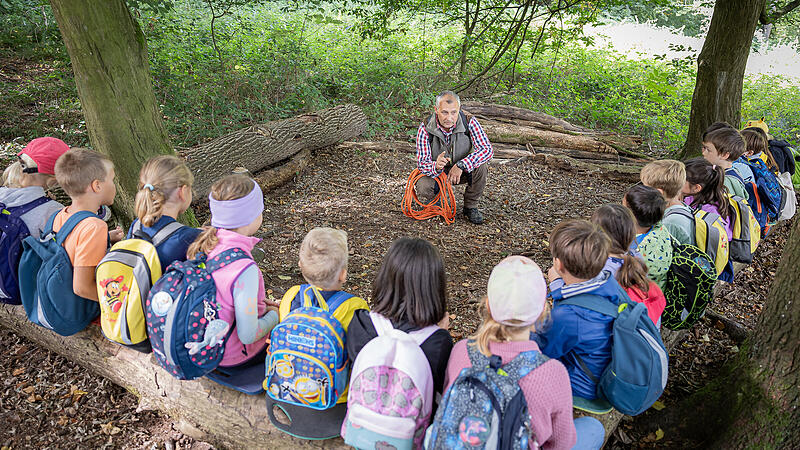Image: Antonio Bayer

Image: Antonio Bayer

Image: Antonio Bayer
Birds chirping, leaves rustling in the wind, distant traffic in Wilhering – the background noise in the Kürnberg Forest is suddenly interrupted: children’s laughter can be heard, students are racing, and in between the words of warning from forest educator Roland Lumetzberger ring out again and again to the Linz elementary school children to slow down a bit: “Always look carefully where you are going. You have to be careful in the forest.”
The path leads over tree trunks and stones, through holes in the ground, nettles and bushes. Meeting points have been set up in several places to give the children space for educational tasks. “What we like to do is the bat game: a child is blindfolded so that they can only rely on their sense of hearing. Then it’s about locating voices and noises. And that’s just one of the many games that “What we do at the stations. Basically, we want to introduce children to the forest habitat for animals and plants, using all their senses,” says Andreas Gschwandegger, district forester and managing director of the Wilhering Forest School, which is located in the old brewery of the Cistercian monastery. A second forest school from the state of Upper Austria is located near the Bohemian Forest.

Image: Antonio Bayer
Leisure behavior has changed
What functions does the forest fulfill? What benefits do people, animals and plants derive from it? What different types of trees can be found here and how old are they? The certified educators deal with these and many other questions on around 130 forest tours a year, when they take more than 2,200 visitors on a journey of discovery through the Kürnberg Forest. “Many people don’t even know what’s going on in the forest anymore. Families – especially in the city – rarely go on trips into nature anymore. The children all have access to electronic devices and prefer to spend their free time that way,” says educator Lumetzberger .
The path leads the elementary school group to a hill – climbing it is the next hurdle when exploring the forest. Lumetzberger attaches the orange rope to a thick tree trunk, then one child after the other climbs up. “Always have both hands on the rope. We wait together at the top,” is the teacher’s instruction.

Image: Antonio Bayer
But the forest doesn’t just offer many adventures for children of primary school age. Visitors of all ages are welcome at the forest school, “we also vary the tours depending on the visitors. In some cases, kindergarten teachers receive further training here, biology teachers visit us, and we also offer lessons in the countryside. There is something for everyone to discover and the forest changes constantly in the annual cycle,” says managing director Gschwandegger.
In order to be as independent of the weather as possible, there is also a lot to discover inside the former brewery: the children make their forest art works from spruce cones, acorns and moss at workbenches. On the upper floor there are specimens of martens, ducks, foxes and other animals that can be found in the forests. “Were they real?” ask the curious students.
Correct behavior in the forest
“Look here, you see a forest dung beetle,” says Lumetzberger, picking up the black, partly blue-shimmering beetle and letting it crawl in his hand. Fascinated, the elementary school children gather around the teacher and observe the insect. “You don’t experience something like that indoors. You have to go out into nature to do that,” says the educator, who has been confronted with many myths and prejudices about the forest several times.
“We even saw a fox hole in the forest,” says a primary school student proudly as the forest excursion comes to an end. “No, there were actually a lot more,” replies another. “And how do you behave properly in the forest, what have you learned today?” is the forest educator’s question. The elementary school children’s hands immediately go up, they all already know: “We’re not allowed to leave trash behind,” “It’s not allowed to make fires here either” and “Screaming in the forest is forbidden – the animals especially don’t like that,” they say Answers like a shot from a pistol.
Become part of our initiative and sponsor a tree!
Together with its partners, OÖNachrichten has set itself the goal of planting 100,000 trees in Upper Austria. To achieve this goal, readers can actively participate in our initiative by sponsoring a tree. And this is how it works:
For our subscribers
As a thank you for your loyalty, we would like to give you a tree sponsorship. You can activate your tree sponsorship at www.nachrichten.at/baumpate. If you have any questions, please do not hesitate to contact us at leserservice@nachrichten.at or 0732 / 7805-560.
For new customers
A tree sponsorship as a gift when you take out a new trial subscription. Order OÖN digital & print now and read everything about forests.
For corporate customers
Would you also like to take part in the campaign? Take on sponsorships for your customers or employees! We look forward to hearing from you: wald@nachrichten.at
My themes
For your saved topics were
new articles found.

info By clicking on the icon you can add the keyword to your topics.
info
By clicking on the icon you open your “my topics” page. They have of 15 keywords saved and would have to remove keywords.
info By clicking on the icon you can remove the keyword from your topics.
Add the topic to your topics.
Source: Nachrichten




